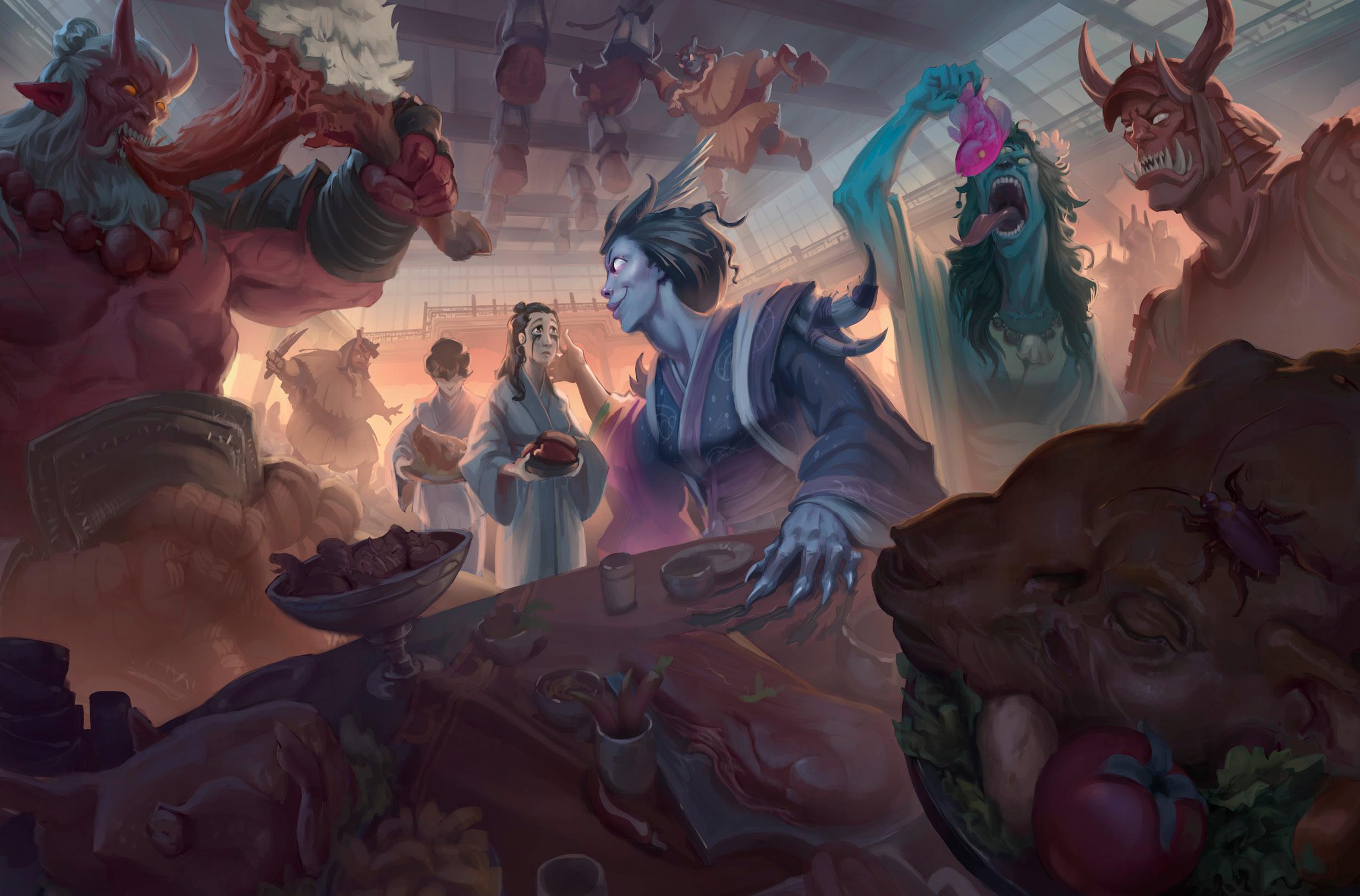“This book was overwhelmingly written by people of Asian descent, but even so, it can’t encapsulate every single viewpoint from the world’s largest continent, in the same way this book can’t offer every single detail on Tian Xia. It instead offers our myriad experiences and ideas, each a different facet of the larger experience. Whether we were born in an Asian country or have only distant memories of grandparents and family traditions, all of us came from real events in Asian history and the culture that arose around those changes. We now return a piece of our perspective to add to the shared world that is Golarion.”1
I love the sidebars Paizo authors and developers work now into every book, especially every Lost Omens tome. The first sidebar of the book is entitled Sharing Our Stories. It’s the quote above. And as I hopefully respectfully called out in my previous article, the Tian Xia World Guide is thankfully a book of numerous contributors sharing their cultures with us. There’s a lot to learn about Tian Xia in this book and, because of the inspirations, our own planet as well. I wish people had the same respect and eagerness to learn and explore. I try to as well, and that goes for the Lost Omens lore here in this guide with great opportunity for adventure and gaming. I couldn’t do just one article on Tian Xia after all!
The Age of Dragons section in History came after the warring of celestial and qlippoth, the Age of Monsters. Here dragons were charged by the goddess Shizuru with a sacred duty. If yaoguai were allowed to continue rampaging and their wars draw on, Tian Xia would be a desolate wasteland. I learned yaoguai is a Chinese term for evil, strange, alien monsters. We might associate demon to it, but for the dragons and Shizuru it was the extraplanar beings bring ruin to the world. Thus the dragons were to prepare the continent for the coming of the lands’ people: humanity. They’d arrive in 10,000 years and the dragons would guard them for 10,000 more. So the dragons took this on, gaining the collaboration of those active celestials to stop yaoguai lords and sealing away the stronger ones. Humanity eventually did come and it’s noted that first they came from Azlant – which we’re familiar with – but first they came from Sarusan. I wasn’t aware Tian Xia’s population was said to have primarily traveled to it.
I know very little of Sarusan but that’s most players and GMs I think. It’s the smallest continent south of Tian Xia. I do know of it as the place where those who visit find their memory of it wiped, missing, or taken. The Pathfinder wiki mentions a scattering of details like a land bridge (mentioned in the same Age of Dragons section) that once existed between Sarusan and Tian Xia. The Gods allegedly destroyed an empire there called Taumata but this section clarifies it was lost due to the rising waters of Earthfall. Was it serpentfolk as apparently there were obelisks of that nature visible to those who could remember seeing them there? While Paizo’s great for setting up mysteries for GMs to establish the why (like Aroden’s death/disappearance), I wonder if Sarusan will always stay the partial mystery. Unfortunately the descendants of Sarusan and Azlant who became the people of Tian Xia didn’t get quite the full protection and support of the dragons. Some meddled too deeply and others took outright rulership of empires. The land was changing quickly as these powerful dragons perished, becoming mountains, volcanoes, huge swaths of forest, or even precious metals like gold or fast moving waterways. Thus humanity was isolated, struggling.
Starting right at the beginning of the Religion chapter and appearing through the book, we get lovely sidebars with Pronunciation guides. First it’s to nearly pronounce the deities’ names phonetically and at least have those that hear appreciate you’re trying. I appreciate that from a general reader’s standpoint who can’t speak any Asia-Pacific languages. My friend recently visiting can speak Japanese quite well, but he noted it’s far from perfect and he’s been living in Japan for over a decade, speaking it every day. It was truly grand to hear him translating words and lovely to see him have to pause to think of the English word for something. Japanese was now the first thing he went to. He was so thrilled to visit Japan and I’m thrilled he has a wonderful life and family there! But yes, what it reminded me of as I went through the book, is that perfection isn’t required but respecting and trying (take the time to learn) is. Later in the book, we get pronunciation guides for major cities, groups, and prominent individuals. Thank you to all those who took the time to put that together for us.
Also in the Religion chapter, I was fascinated to learn more about the Celestial Court. The section starts noting technically anyone can become a deity or immortal. There’s many ways from alchemy to amassing power to reaching spiritual enlightenment. In this case Shizuru formed this initial organization of divine powers to help bring some order to the chaos, partially to help bring order to the mortal world. Depending on how you reached enlightenment, you likely were granted tasks based on your ascension. The write-up notes it as a meritocracy though it’s noted some rebel and also your activities are tracked. Go too far, act without wisdom in revealing your power, cause destruction and you’ll get the ire of the others. I think that’s fair as even a sliver of divine power could be too much for the common individual working day to day. There’s ample examples of why this could go badly, and I think it also speaks to why major heroes can’t get involved in everything. Why are the former PCs from Sandpoint not swooping in to help even though they’ve got Mythic abilities? Well it would draw unnecessary attention, create religions unintentionally, etc. So it’s the same for the Celestial Court. However, I do find the idea that this court takes highly detailed notes, resulting in a grand record of society, history, politics, science… magic? Is it recorded what happened to Aroden, hm? I sense a great opportunity for an adventure where one might have to get access to or protect these records. There’s also a favor and promise exchange that could lead to hijinx or trouble. There’s one page here on the Celestial Court but it’s all lore and it’s a very valuable read.
I’ll also mention that many of the deities listed have reference to the forthcoming Divine Mysteries and some to Player Core 2. Domains like change, duty, glyph, plague, repose and spells like animal vision, blanket of stars, feast of ashes, and penumbral shroud. I noticed as I read through each god and the Lady of the North Star further caught my attention. Her name is lost to time and apparently Pharasma’s faithful help scrub her name from history. I guess they are allies because she takes pity on those who are suffering incurable curses and other ailments. Her areas of concern include immortality and I wonder if she was actually mortal long ago. She at least visited as a mortal – stories say – but maybe it’s when she was mortal? She has a nine-part secret, hidden, mysterious ritual that allows one to gain immortality. I’m not sure I’d like that form of immortality though as it requires you to dwell in darkness beyond the stars to the North where it’s so cold even the “wheels of time” are frozen. If Zon-Kuthon taught me anything, it’s not to go venturing beyond the stars. This whole secret goddess with a path to immortality in 9 stages sure reeks of an adventure path to me!
I mentioned Chue Ye, a land dominated by dangerous Oni, in my last article. Obviously it’s more than just a dangerous place. I found the cultural section particularly interesting. It starts with a discussion of the Oni and that they measure their own self-worth through their own accomplishment, caring little for the gods’s opinions who punished them “for failures beyond their control.” You might have heard/read that Oni are no longer considered Fiends after the Remaster. They’re still giant humanoids, yes, but fiends they are not. They are former kami, nature spirits that suffered some great trauma. So many Oni, especially in Chue Ye, are not only spirits in a state of perpetual trauma but also feel abandoned and punished. At least in Chue Ye they’fe started to develop a new social structure and thus decided on rulership over destruction, murder, or “wanton slaughter.” There’s some opportunity there I think, and I love the new positioning. Meanwhile the Human section speaks to the invention of acupuncture in Chue Ye and the study of qi, both originating in this country. While humans are generally suffering and have little, their studies went with those who fled Chue Ye but also were granted to Samsarans so the knowledge would not be lost. That section – Kitsune and Samsarans – speaks to the preservation of culture through the past life knowledge. Meanwhile some Kitsune have begun worshiping Fumeiyoshi – god of envy – and gain the ability to take an Oni form if they slay an Oni who displeased the god. More corruptive and damaging spiritual evidence is clearly visible here. Some kitsune use the ability to help rebel groups but others are fully becoming Oni. Makes me interested in exploring this region even more. I love the diversity this adds to those ancestries, really showing the cultural and societal changes for Oni and Kitsune alike.
I’d heard that Goka was inspired by Hong Kong and reading through, I can see why. It’s perhaps bigger than Absalom, founded by an Abadarite named Xhai Xen Ciao. I also learned from the Paizo Blog article featuring the authors, which went live the day of my last article, that it was Tan Shao Han who wrote the area of Songbai as well as this section. Definitely check out this bsky thread on things they noted, changed from 1E, etc! Goka’s a huge bustling port with many different forms of commerce. Trade might be one of them with ships sailing in and out for/from every continent but there’s fishing, farming, skyscrapers of business, construction, urban growth and renewal, gambling casino, and of course entertainment. You might find a storyteller or singer on the street corner, or perhaps you’re going to an all-male band – boy band inspired clearly – termed beautiful garden. They sing and dance and there’s some groups with fame all across the world. There’s a smaller, more intimate form called goyao, which appears to translate to “go want” (thanks Google, maybe) but also possibly adventurer. Want dinner and a show? Well Gokoa is also known for casual dining and street-side shops. Go to a coffee shop known as kopi-tiams, finding snacks from across Golarion or grab a larger meal and sit street-side with the hustling and bustling mixture of locals and visitors. I’ll note however that apparently sparkle tea (bubble and boba tea) is the rage with jellied fruit, chewy tapioca parts, etc. Of course recent events in Goka include the Fists of the Ruby Phoenix adventure path and the ramifications of Hao Jin’s tournament. Hao Jin is still present and active – unless that’s different from your playthrough – though feeling a little down by the looks of it. I want to meet and learn more of this “sharp-witted, self-assured” comb-spirit named Bao Ting. Yep, a comb spirit that is Hao Jin’s oldest friend.
Meanwhile, things in Lingshen are wild. It’s a nation with a mighty military history, which grew after the former Lung Wa empire fell. But things have been changing, albeit not for great reasons. There’s a state of detente, which I did not know what that even meant. Apparently detente means the eating of hostility or strained relations, usually in context of politics or between different countries. It’s noted because Lingshen continues to heavily train and develop its military, but why? The former King Shixin is dead and his 11 remaining children aren’t so much ruling together, but fighting one another, which the former King had encouraged to encourage strength in them. Well that’s not going to do well for the country as they create friction for their people and no single leader can truly step up. Meanwhile and this may be a spoiler if you’re a player, but… the King had a whole plan to get his mind transferred to a construct using Sun Orchid Elixir. He also set up an impossible task to lift a keystone from a pedestal to prove one was the rightful leader of Lingshen. Well, impossible for any mortal, but a magical construct? Sure! It’s giving automaton vibes though there’s a note the process maybe has corrupted the King’s mental state… And that’s all from the first page, everyone! We get details on all the kids, including the young ones either a struggle to protect or being manipulated by others. I suspect we’ll learn more about Li Mingxian, a scientist whose work has been turned into military innovations so they undermine and work with other nations like Goka and Songbai. This nation’s really in trouble.
If I had to choose anywhere to send characters, it’d be the Forest of Spirits. This area is north of Minkai (considered part of that nation), both feared and honored, filled with mystery kami, those nature spirits. While many consider it haunted and there’s no traditional settlements within, there’s still much life and magic alive in the dense woods. Technically there’s a traveling road with a few small villages along the southwestern coast, abutting the forest. People know better than to threaten nature and anger the spirits; they’ve made agreements with the kami as such. The important part is – like with anyone or anything – to treat it with respect. There’s even an old temple to a fallen samurai who learned this the hard way. Still people will come to learn and explore like some traveling spiritualist, but also those seeking gain. Locals aren’t amused but some are enjoying the new interest financially anyway. Maybe there’s a secret village or two, but I won’t give those away! I’d just want to marvel at the majesty of it all. The art alone (see below) is wonderous. Traveling along the Spirit Road on that southern border you can meet spirits of the things discarded along it or into the forest, an old tradition from past generations resulting in many abandoned items. Further in, maybe I could catch some of the spirits dancing and join in. Maybe I’d witness a bit of divine power to Desna or Sun Wukong. Remember to respect the moths by the way… Insects are part of nature after all! Too far north and you might enter Chinmoku where the restless dead wander. There’s apparently an area on the Aokori Gulf where five massive skulls mark a sacred spot where you can request aid and others celebrate the changing of seasons, even as whatever spirits guard that area watch the sea. A great location to send adventurers seeking special help in their quest!
I really wanted to go into Shenmen, but with the recent Season of Ghosts adventure path, I won’t give anything away except well… it’s based there! The only warning I’ll give is a content warning for spiders! There’s so much more to the Tian Xia World Guide to learn and explore than I can put into words. Thankfully all the authors have done so, with inspiring images by the artists to help. You most certainly should invest in the lore and every detail of this book. What’s your favorite detail? What’s been happening in Tian Xia for a long time that you’re just now learning? What real-world aspect has been brought to life in Golarion that you recognize? Let me know as you learn about Tian Xia!
Investing In:
I wasn’t quite sure what to name my article series when I first started but the idea of showcasing or discussing things that make me excited, that I find new and interesting, or maybe I’m otherwise passionate about seemed to fit with the idea of Investing In something like the Pathfinder 2E mechanic. To use some magic items you have to give that little bit of yourself, which helps make these things even better. I like the metaphor of the community growing and being strengthened in the same way!
I also want to hear what you’re Investing In! Leave me a comment below about what games, modules, systems, products, people, live streams, etc you enjoy! You can also hit me up on social media as silentinfinity. I want to hear what excites you and what you’re passionate about. There’s so much wonderful content, people, groups (I could go on) in this community of ours that the more we invest in and share, the better it becomes!
Sources
Banner – Tian Xia World Guide cover, Paizo, art by Ekaterina Gordeeva
- Sharing Our Stories sidebar, Introduction, Tian Xia World Guide, Paizo
- Alley Basher image, Goka, Tian Xia World Guide, Paizo, art by by Sandra Posada
- Test of Fate, Tian Xia World Guide, Paizo, art by Maichol Quinto
- Chu Ye banner, Tian Xia World Guide, Paizo
- Empress Nai Yan Fei, Goka, Tian Xia World Guide, Paizo, art by Vira Linevych
- Hao Jin, Tales of Lost Omen: Rebirth blog, Paizo, art by Vladislav Orlowski
- Huang Shixin, pretty bad father from Lingshen, Tian Xia World Guide, Paizo
- Forest of Spirits banner, Tian Xia World Guide, Paizo













